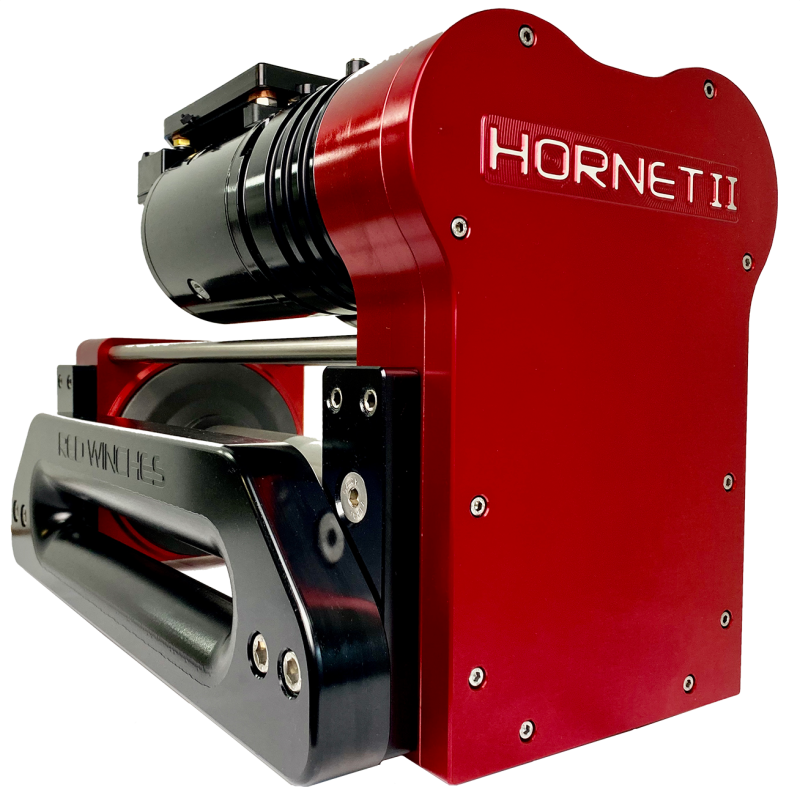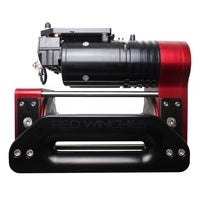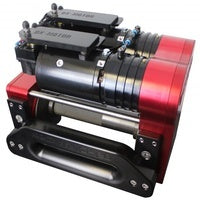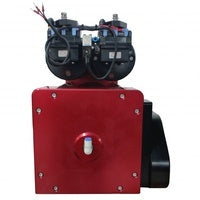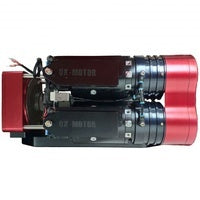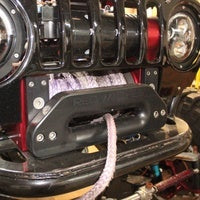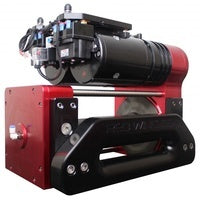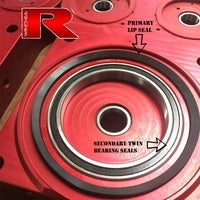Red Winches
Red Winches Hornet 2 +76mm, 12v, 4500kg (10,000lbs) STD Gearing
Red Winches Hornet 2 +76mm, 12v, 4500kg (10,000lbs) STD Gearing
Couldn't load pickup availability
THE HORNET WINCH (12V)
RED WINCHES GENERALLY HAVE A 6-8 WEEK BUILD/SHIP TIME, WE KEEP SOME MODELS IN STOCK PLEASE CONTACT US FOR MORE INFORMATION
STANDARD WIDTH (+76MM)
The Hornet is the ultimate choice when it comes to the best competition electric winch for your vehicle. The RED Winch engineers have designed and developed this high-performance twin motor electric winch for the 4×4 competition and Motorsport markets.
It has been designed with the competition in mind and has many features ideally suited to high-performance Motorsport events.
All products at RED winches have been through an extensive design and testing program before going on sale (engineered to meet J706 standards).
The winch body is CNC machined from high-grade heat-treated aerospace aluminium from solid billets. We only use the best machine tools and machining processes to ensure stress in the material is kept to a minimum and strength to its maximum. With its air free spool and air brake system, the Hornet offers control and reliability previously unavailable on a winch to the off-road and motorsport sectors.
HORNET PACKAGE
When you order your Hornet will come with the following:
Hornet-2 winch with anodised RED CNC machined body and air brake system
Solenoid for brake operation built onto the winch during assembly
High-efficiency copper bus bar assemblies for the motor power connections
Albright heavy-duty Ultimate solenoids x 2
Hard Anodised Aluminium fairlead
Plasma Lock
Mounting Bolts
User Manual
THE RED WINCH AIR BRAKE SYSTEM
Spring pressure applies a steel disc to the brake material when the winch is not in use.
This applies the brake at the motor drive and stops the winch from spooling out.
The brakes work in a way that they only come off or release when a voltage is applied to the motor solenoid signal terminals. When a signal is sent to the winch to operate either forward or reverse that same signal is used to energise the air solenoid that feeds the brake system.
An air solenoid is fitted in-between the motors at the top of the winch. This is fed by an air supply from your truck or remote compressor. Min 5bar (70 PSI) required.
When you winch in or out you energise the signal terminals on the motor Albright solenoids this also energises the air brake solenoid valve. This then allows air to go into a specially designed chamber inside the air brake unit that releases the brake disc instantly.
When you remove your winching finger from the controls the air solenoid dumps the air and the springs apply the brake disc onto the brake pads. We can vary the number of springs in the brake to suit the weight of the vehicle if necessary but so far this has not been needed. More springs equal larger braking force but more abrupt stopping which can cause snatching which we do not recommend for the sake of your rope life.
One nice feature is when you are lowering out you can switch your isolator off to the winch (no power to the motors) and just flick the winch out button on your dash. This still activates the air solenoid and releases the brake and your vehicle only pulls out rope off the drum for the amount of drop your vehicle needs or moves. This means compared to normal winching you do not get overrun or excess rope coming off the drum and out the back of your truck causing snatching and jerking as the vehicle takes up the slack rope that has been spooled out.
We would expect a set of brake pads to last at least 2 seasons if not 3 seasons due to the material they are made from. This air brake design has been submitted for full patent and is patent pending.
PULLING CAPACITY / SETUP
Line pulling power with electrics is in a world of its own as you probably know…and depends heavily on the quality of your electrical setup as described in the electrical section.
As a guide, for the standard Hornet winch you will need this as your electrical setup:
- Twin alternators, one for the vehicle and one for the winching batteries of 200A Min
- Two batteries supplying the winch with enough power, and one battery for the vehicle electrics
- At least 70mm² high-quality electrical cable, ideally one 70mm² cable per motor
- Clean electrical joints and if in areas prone to water joints should have conductive grease applied
The Hornet can give you speeds of 40m/min (131ft/min) for the standard 12v model, and 60m/min (197ft/min) with the Hornet ‘Overdrive’ gear set giving you a choice so you have the power and speed when you need it.
GEARBOX
The gearbox has been specifically designed for strength, power, and ease of service. All gears are manufactured from 655-M13 nickel chromium-molybdenum steel and case hardened to give maximum strength (1100 N/mm²) and excellent durability. Straight cut gears provide strength where its most needed.
The end cover is sealed via an O-ring and groove, ensuring a watertight seal. Once the cover is removed access to all gears is possible and only takes 5 mins to service / inspect all gears and re-assemble. The gearbox runs in grease, not oil making it much easier to service in the field.
SETUP PROCEDURE
(1) Check winch as per the safety instructions
(2) Check winch is situated correctly for the task at hand
(3) Check rope is on drum securely and is not tangled
(4) Check power connection to winch
(5) Ensure Compressor is on and the winch has air pressure to it
(6) The winch is now ready to operate
STARTUP
The winch can release and winch in rope very fast, this is much faster than a normal winch, so please operate with caution when first using the winch.
The winch gearbox is slightly noisier than other winches due to the rotational speeds of the gears, especially when not under load. Do not be alarmed by the noise, this is normal.
The compressor will run and vibrate whenever it needs to top-up the air in the system, the winch uses very little air to operate but this compressor could start when the winch is not being operated if the air pressure in the system drops.
SPEEDS AND POWER
The Hornet can give you speeds of 40m/min (131ft/min) for the standard 12v model, and 60m/min (197ft/min) with the Hornet ‘Overdrive’ gear set giving you a choice so you have the power and speed when you need it.
Important Note:
A vehicle with driver has to be 1800kg or less for overdrive gear set to work successfully
You can also overvolt the winch motors (24v onto 12v Motors), its a very common practice in competition use. We ask you to consider this option with caution, as the motors are working much harder than normal and need to be looked after more than if they were being used in normal operation. The winch must not be operated for long periods (5 secs or more) when not under load.
So no-load line retrieval you would use short bursts when winching in
But, many people do overvolt and it works very well for them, it gives the winch incredible power and speed.
As standard, the winch is capable of pulling a minimum of 4500kg with 12v and the standard gear set.
THE AIR FREE-SPOOL
A piston in the end of the drive shaft moves a large clutch plate in and out.
This clutch plate locates over 4 drive pins that are mounted into the drum
The clutch plate moves in and out on a splined shaft that is greased.
ELECTRICAL POWER
The electrical power of this winch is supplied by our top-end ultimate winch motor, the OX motor.
This copper bus bar assembly we use supplies an excellent quality connection to the motors.
Don’t be fooled by thinner copper bars, our extensive testing has shown thinner doesn’t support the demand the motors require from the electrical supply.
The high power Albright solenoid packs are used to switch the direction of the motors and to also provide a feed to the air solenoid for the brake system.
Power, speed, and stamina of the winch is very much variable due to how your vehicle is set up and the quality of the components used in your electrical system and alternator supplying the winch. It also depends on the scale of electrical losses or inefficiencies in your wiring system.
The control voltage selection on the motor solenoid / Albright is for the voltage that will be used/applied to the 3 spade terminals on the Albright motor solenoid.
The Albright power terminals on top can transmit 12v & 24v through them as standard.
We test with x2 Odyssey PC1750 batteries, 12V supply and power, and negative connections made with 70mm² cable.
DRUM & CAPACITY
Standard Drum:
The Std drum can hold 65m of 10mm plasma or synthetic rope.
The Std drum can hold 55m of 11mm plasma or synthetic rope.
The Std drum can hold 45m of 12mm plasma or synthetic rope.
XL Drum:
The XL drum can hold 90m of 10mm plasma or synthetic rope.
The XL drum can hold 78m of 11mm plasma or synthetic rope.
The XL drum can hold 67m of 12mm plasma or synthetic rope.
These figures are the maximum amount of rope when precision wound. We always recommend using 15% less rope to allow for line crossing and bunching.
The drive onto the drum is mechanically provided by a solid steel hardened clutch plate. This is a very tough hardened plate that engages via spring pressure and disengages using an air supply (Air Freespool). The clutch plate is driven from the gearbox by a solid steel central shaft. The drive system has been built for strength and durability. When not engaged the ‘free-spool’ of the Hornet drum is only between two roller bearings so it is extremely free moving to allow the co-driver to run freely with the rope.
The winch is supplied with a “Plasma Lock” to hold the synthetic rope onto the drum. It’s a proven method and very reliable. It is a nice simple solution to ensure you always have the minimum amount of line wraps on your winch drum. Its robust, cheap, and easy to keep spares just in case…
SERVICEABILITY
The Hornet has been designed with both competition use and servicing in mind. A mounting block is provided to interface between the winch and the mounting frame. This reduces the risk of stripping the threads in the winch casing. The free-spool assembly is held in place with machine screws for ease of service. The brake assembly is held on with x4 socket head bolts, allowing full access to the brake pads for service. Brake pads can be changed in 15 minutes.
WEIGHTS
- Standard Winch: 55kg (Without Rope)
- Shipping Weight: 70kg (with no rope or accessories)
- XL Winch 65kg (without Rope)
- Shipping Weight: 80kg (with no rope or accessories)
